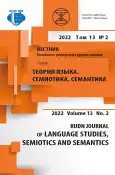Neology Process in the Era of the COVID-19 Pandemic: Spanish and French Media and Social Networks Discourse
- Autores: Zvereva E.V.1
-
Afiliações:
- Peoples’ Friendship University of Russia (RUDN university)
- Edição: Volume 13, Nº 2 (2022)
- Páginas: 364-381
- Seção: COGNITIVE RESEARCH
- URL: https://journal-vniispk.ru/2313-2299/article/view/323502
- DOI: https://doi.org/10.22363/2313-2299-2022-13-2-364-381
- ID: 323502
Citar
Texto integral
Resumo
The study aims to explore features of the realization of the neological potential of lexemes created or rethought by the new reality and included in the COVID-19 concept sphere. It identifies the specifics of derivation and lexical-semantic ways of forming these neologisms. The research material includes more than 1000 articles from the most influential Hispanic and French-language publications and correspondence of native speakers in social networks and telephone applications in a synchronous cut over eight months of the pandemic. A vital factor for choice of material refers to the fact that the mentioned channels have formed a global communication environment that intensively contributes to the creation and dissemination of neology products. The methodology rests on the discursive and communicative approaches. It includes analysis and synthesis of theoretical research and applies continuous sampling of research material from the mentioned sources. The study establishes that the multidirectional processes distinguish the media and social networks’ discourse during the pandemic. Changes in the lexical-semantic discourse are carried out by creating neologisms, which, along with borrowings assimilated into the grammatical system or functioning in parallel with the national concept definition, are productive means of replenishing the lexis. The semantic neology’s main mechanisms are metaphorization and metonymization and changes in the semantic volume of a lexeme. Modern new formations perform pragmatic functions, making it possible to strengthen the emotional and modal interaction. The author concludes that neological processes demonstrate each language’s national and cultural originality and establishes that the linguistic norm in Spanish and French discourse does not conflict with the “disruptive” nature of linguistic innovations. The society positively evaluates the formation of individual speech meanings and linguistic meanings and the expansion of their functioning boundaries.
Palavras-chave
Sobre autores
Ekaterina Zvereva
Peoples’ Friendship University of Russia (RUDN university)
Autor responsável pela correspondência
Email: zvereva-ev@rudn.ru
ORCID ID: 0000-0003-2268-0580
PhD in Linguistics, Associate Professor at the Department of Foreign Languages in Law Institute
6, Miklukho-Maklaya str., Moscow, Russian Federation, 117198Bibliografia
- Mikhaleva, O. (2008). Political discourse: Specifics of MANIPULATIVE influence. Moscow: URSS. (In Russ.).
- Van Dijk, T. (1989). Estructuras y funciones del discurso: Una introducción interdisciplinaria a la lingüística del texto y a los estudios del discurso. México, D.F.: Siglo XXI.
- Cortés Rodríguez, L. & Camacho, M. (2003). ¿Qué es el análisis del discurso? Barcelona: Octaedro-EUB.
- Escandell-Vidal, M. (2014). La comunicación: Lengua, cognición y sociedad. Madrid: Akal.
- Calsamiglia Blancafort, H. & Tusón Valls, A. (2012). Las cosas del decir. Manual de análisis del discurso.Barcelona: Ariel lingüistica.
- Vinogradov, V. (2005). Neologisms and occasional words in the original and in translation. In: Introduction to translation studies (General and lexical questions). Moscow: Nauka. (In Russ.).
- Kotelova, N. (1983). Word formation without the formation of words. In: New words and dictionaries of new words. Leningrad: Nauka. (In Russ.).
- Sanchez Manzanares, C. & Azorín Fernandez, D. (2016). Estudios de Neología del Español. Murcia: Universidad de Murcia.
- Arrieta de Meza, B., Meza Cepeda, R. & Batista Ojeda, J. (2008). ¿Neologismos o desacieros linguísticos? Revista de Investigación Lingüística, 11, 361-376.
- Díaz Rojo, J. (2010). El lenguaje valorativo en noticias periodísticas españolas sobre avancas médicos. Revista de esudios filologicos, 20, 1577-1584.
- Martinet, A. (1993). Función y dinámica de las lenguas. Madrid: Gredos.
- Lúdi, G & Hóche, K. (2016). Managing plurilingual and intercultural practices in the workplace. The case of plurilingual Switzerland. Amsterdam: John Benjamins.
- Llopart-Saumell, E. (2019). Los neologismos desde una perspectiva funcional: Correlación entre percepción y datos empíricos. Revista Signos, 52, 100, 665-687.
- Mounin, G. (1990). Quelques observations sur le lexique français d’aujourd’hui. Europe, 738, 10-18.
- Estadísticas sobre «El consumo de prensa en España». URL: https://es.statista.com/ estadisticas/476795/periodicos-diarios-mas-leidos-en-espana/ (accessed: 18.04.2020).
- Los principales periodicos del habla hispana, 2019. URL: https://www.portada-online.com/latest-news/los-principales-periodicos-de-habla-hispana/ (accessed: 12.05.2020).
- Classement des journaux de presse quotidienne national. URL: https://fr.statista.com/statistiques/527259/journaux-presse-quotidienne-nationale-diffusion-payee-france/ (accessed: 8.03.2020).
- Cuota de pantalla de los principales canales de televisión en España en 2019. URL: https://es.statista.com/estadisticas/480508/principales-canales-de-television-en-espana-por-cuotade-pantalla/ (accessed: 8.03.2020).
- Audiences TV 2019. URL:https://www.20minutes.fr/arts-stars/television/2684639-20191230audiences-tv-2019-tf1-tete-85-100-programmes-plus-regardes-sous-20-part-marche (accessed: 16.03.2020).
- Diccionario de la lengua española. Versión electrónica. URL: https://dle.rae.es/diccionario (accessed: 22.04.2020).
- Diccionario de términos médicos. Versión electrónica. URL: https://dtme.ranm.es/index.aspx (accessed: 20.04.2020).
- Larousse. Dicctionnaire de francais. Versión electrónica. URL: https://www.larousse.fr/dictionnaires/francais/confinement/18092 (accessed: 20.04.2020).
- Alvar Ezquerra, M. (2003). Nuevo diccionario de voces de uso actual. Madrid: Arco Libros.
- Dicccionario Clave. Versión electrónica. URL:http://clave.smdiccionarios.com/app.php (accessed: 20.04.2020).
- García Platero, J. (2015). La innovación léxica en español. Perspectivas de análisis. Vigo: Academia del Hispanismo.
- Nueva gramática de la lengua española. Morfología y sintaxis. (2020). Madrid: Espasa.
- Baccus, N. (2017). Grammaire francaise. Paris: Broché.
- Desescalada: de no recomendable a válido para la RAE en dos semanas. URL: https://www.marca.com/tiramillas/2020/04/21/5e9eb40f46163ff3918b45b2.html (accessed: 20.04.2020).
- Crisis del COVID-19: apuntes sobre pandemia en la lengua española. URL: https://www.rae.es/noticias/crisis-del-covid-19-sobre-la-escritura-de-coronavirus (accessed: 22.04.2020).
- La pandemia, según yo. URL: https://www.lavoz.com.ar/opinion/pandemia-segun-yo/ (accessed: 05.05.2020).
- Une quatorzaine “volontaire” pour les expatriés. URL: https://lepetitjournal.com/expat-pratique/retour-en-france/quatorzaine-volontaire-expatries-retour-francecoronavirus-280811 (accessed: 16.05.2020).
- Coronavirus. Cluster, quatorzaine, super spreader. Les mots de l’épidémie. URL: https://www.ouest-france.fr/sante/virus/coronavirus/coronavirus-cluster-quatorzaine-super-spreader-lesmots-de-l-epidemie-6783539 (accessed: 08.05.2020).
Arquivos suplementares









